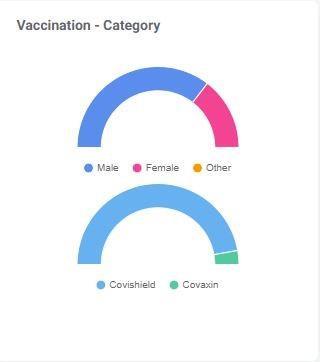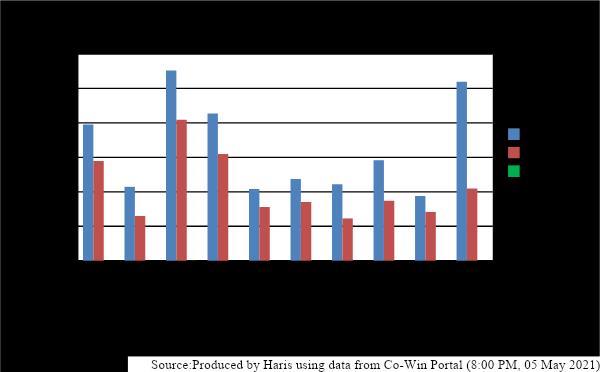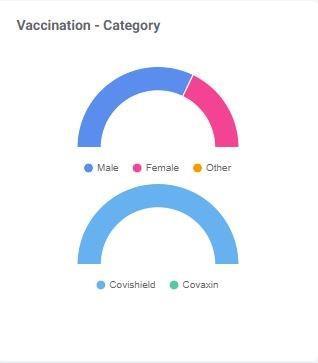(MENAFN- Kashmir Observer)
By Haris Rashid
THERE is a huge difference in the number of women and men who are getting vaccinated against Covid-19 in different districts of the Kashmir division of Jammu and Kashmir Union Territory. According to the data available on India's COVID-19 Vaccine Intelligence Network (Co-WIN) portal, which tracks the beneficiaries on a real-time basis, Srinagar has the highest gendered difference of vaccinated individuals. The gendered data which counts individuals on the basis of Dose 1, paints a bleak picture of Srinagar district where 'females' constitute only 29% of the overall vaccinated population as of 5 May 2021 (accessed on 8:00 PM).

Vaccination Data for District Srinagar
Women, especially above 45 years of age, do not seem enthusiastic about getting protected against the severity of the Covid-19 infection. One day before the third phase started in Srinagar, females constituted 27% of the vaccinated population in Srinagar. Although the number of women beneficiaries has picked up a little since the opening of vaccination for the age group of 18-45 age group, it is still a cause of concern.
For the country as a whole, women make up for 48% of the total beneficiaries while for Jammu and Kashmir, women constitute 41% of the total vaccinated population. At present, four out of the ten districts of the Kashmir division have a lesser number of women getting vaccinated against men than that of the UT level of 41%. In the remaining six districts, each three of them have 42% and 43% of women among the vaccinated population.

In Srinagar district, 71 men are getting vaccinated against every 29 women and for Kupwara the ratio is 64 men to 36 women.
Thank you for connecting with us. We will respond to you shortly.
BE PART OF QUALITY JOURNALISM
11https://kashmirobserver.net/wp-content/plugins/nex-formsfalsehttps://kashmirobserver.net/support-our-journalism/redirecthttps://kashmirobserver.net/wp-admin/admin-ajax.phphttps://kashmirobserver.net/2021/05/06/gendered-vaccination-less-women-are-getting-vaccinated-in-kashmiryes1fadeInfadeOut Subscribe Now for NewsletterSubmit

Vaccination Data for District Kupwara
This gendered data on vaccine beneficiaries raises several compelling questions. Why in comparison to men are fewer women getting vaccinated in several districts of Kashmir? Given that the existing data is mostly about beneficiaries who are above 45 years of age, it is assumed that most of them are married and living with their families. That would mean that there are a lot of families whose male members are getting vaccinated while female members are not.
Now compare the data of Covid-19 vaccination with the immunization data of children of 0-5 age in urban areas of J and K. The percentage of fully immunised girls (68%) outnumbers boys (65.7%) according to the Health and Family Welfare Statistics in India 2019-2020 report of Ministry of Health and Family Welfare Government of India. Even though it is a comparison of children with elders, but it is still an indicator that women have equitable access to healthcare. Also, at the risk of stereotyping, but from a sociological point of view, women, especially mothers, are expected to seek vaccination more than men because of their association with child care and child immunization programs. This, in the case of covid-19 vaccination, should rule out any possibility of women not being cared for or not having access to vaccination centres. The only plausible explanation of such a huge gender difference in Covid-19 vaccination beneficiaries would be that of vaccine hesitancy. This becomes more important as the use of sterility/infertility and menstrual rumours related to Covid-19 vaccination are increasingly commonplace, sowing fear in women. This gendered vaccine hesitancy is further contributing to gender inequities in Kashmir. As of now, the vaccination program in Kashmir has failed to recognize these constraints that women face in utilising the vaccination services.
The government and the civil society in Kashmir, including Mohalla Auqaf Committees and NGOs, should encourage more women to take the vaccine by making them aware of the mechanisms in which the vaccines work. Vehicles that are announcing lockdown through loudspeakers should also be used to disseminate information on vaccines. Besides, to make vaccination easy and accessible for women, the government can set up all-women vaccination centres. It can further incentivise the vaccination for women by offering them other benefits. Presently, the government might be sitting back on encouraging women for vaccination due to vaccine shortage but once the vaccine is made available, it would be difficult to break with the precedent that is being set right now. Right now, if more women of the age of 45 years above are encouraged to take the vaccine, they will later in the third phase, inspire and encourage younger women in the age group of 18-45 years of their families to take the shot.
Views expressed in the article are the author's own and do not necessarily represent the editorial stance of Kashmir Observer
- The author is a student at Ashoka University and can be reached at [email protected]
| Be Part of Quality Journalism |
| |
| Quality journalism takes a lot of time, money and hard work to produce and despite all the hardships we still do it. Our reporters and editors are working overtime in Kashmir and beyond to cover what you care about, break big stories, and expose injustices that can change lives. Today more people are reading Kashmir Observer than ever, but only a handful are paying while advertising revenues are falling fast. |
| ACT NOW |
| MONTHLY | Rs 100 |

|
| | | |
| YEARLY | Rs 1000 |

|
| | | |
| LIFETIME | Rs 10000 |

|
| | | |
MENAFN06052021000215011059ID1102041775
Legal Disclaimer:
MENAFN provides the information “as is” without warranty of any kind. We do not accept any responsibility or liability for the accuracy, content, images, videos, licenses, completeness, legality, or reliability of the information contained in this article. If you have any complaints or copyright issues related to this article, kindly contact the provider above.